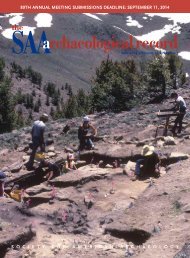SAA
SAA_Record_Nov2015
SAA_Record_Nov2015
You also want an ePaper? Increase the reach of your titles
YUMPU automatically turns print PDFs into web optimized ePapers that Google loves.
PROS AND CONS OF CONSULTING COLLECTORS<br />
THE BENEFITS AND BURDENS OF PRIVATE<br />
ARTIFACT COLLECTIONS<br />
A PERSPECTIVE FROM SOUTHWESTERN GERMANY<br />
Lynn E. Fisher, Susan K. Harris, Rainer Schreg, and Corina Knipper<br />
Lynn E. Fisher is Associate Professor in the Sociology/Anthropology Department of the University of Illinois, Springfield. Susan K. Harris is an<br />
independent researcher in Santa Barbara, California. Rainer Schreg is a researcher at the Römisch-Germanisches Zentralmuseum in Mainz (RGZM),<br />
Germany. Corina Knipper is a research associate at the Curt Engelhorn Center for Archaeometry in Mannheim, Germany.<br />
From a central European perspective, professional<br />
archaeologists (i.e., university-trained archaeologists<br />
with positions in research institutions or state cultural<br />
heritage protection agencies) and nonprofessionals who<br />
devote substantial time to archaeological investigation as private<br />
individuals have a long shared history of discovering<br />
and investigating the past. They also, one can argue, share<br />
responsibility for protecting and interpreting the record of<br />
past cultures. In Germany, as in the U.S., archaeologists<br />
debate the ethics of working with privately held collections,<br />
worrying that objects in private hands may be unavailable for<br />
research, that provenience information may be lost when<br />
collections change hands, or that items with scientific value<br />
may be sold for profit. Profit-oriented looting of archaeological<br />
sites, particularly sites with coins and other metal<br />
objects, is a growing problem. Though in many cases cultural<br />
heritage preservation laws in Germany make objects of<br />
special scientific value the property of the state (even when<br />
found on private lands), difficult legal and ethical debates<br />
surround issues of ownership of chance finds (e.g., coin<br />
hoards or other “treasure”) on private property.<br />
Against this background of sometimes uneasy relations<br />
between professional archaeologists and private individuals<br />
who amass artifact collections, we explore the benefits of<br />
close collaboration and outreach. We present a case study<br />
from southern Germany, illustrating this region’s long tradition<br />
of positive collaborative engagement and significant<br />
contributions made by private individuals devoted to archaeology.<br />
Conditions of cooperation have changed as archaeological<br />
practice and heritage preservation law have developed<br />
over the last 50 years, raising new and important questions<br />
about how to sustain and best serve what is most valuable in<br />
this kind of collaboration, while also protecting the archaeological<br />
record.<br />
We are a U.S./German team researching Neolithic settlement<br />
on the Swabian Alb in southwestern Germany. As we<br />
prepared to conduct a regional survey in 2001, the State<br />
Office for Historic Preservation provided a map of known<br />
sites plus a short list of local people with artifact collections.<br />
All were in regular contact with state preservation officers<br />
and reported their finds, and most either planned to donate<br />
or had already donated collections to local or state museums.<br />
We spent our first summer in the field visiting private<br />
homes and local museums, where we examined collections,<br />
pored over maps, and asked about field methods and documentation.<br />
These conversations helped us plan our research<br />
and led to nearly a decade of close collaboration with Mr.<br />
Helmut Mollenkopf (1929–2009).<br />
Meanwhile, Schreg and Knipper had begun analyzing the<br />
collections of Mr. Albert Kley (1907–2000), a teacher and<br />
artist who spent decades documenting sites on the Swabian<br />
Alb in his spare time. Building on Schreg’s work with Kley<br />
during his lifetime (Kley and Schreg 1992), Schreg and Knipper<br />
took on the mammoth task, still ongoing, of preparing<br />
these collections for curation at a state repository.<br />
Neolithic sites documented in these and other collections<br />
became the foundation of our long-term research on the<br />
Swabian Alb (Fisher et al. 2013; Knipper et al. 2005). Here we<br />
consider the contributions of Kley, Mollenkopf, and Robert<br />
Bollow, a private individual active in the region’s archaeology<br />
today, in the context of changing archaeological practice in<br />
Germany.<br />
Changing Contexts of Archaeological Practice<br />
In many regions of Europe, “good cooperation with wellinformed<br />
amateur archaeologists” is regarded as critical for<br />
24 The <strong>SAA</strong> Archaeological Record • November 2015




